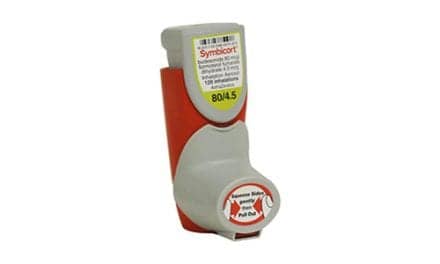An automatic, electronic alert on general practitioners’ computer screens can help to prevent excessive prescribing of short-acting asthma reliever medication, according to research presented at the virtual European Respiratory Society International Congress.
The alert pops up when physicians open the medical records for a patient who has been issued with three prescriptions for short-acting reliever inhalers, such as salbutamol, within a three-month period. It suggests the patient should have an asthma review to assess symptoms and improve asthma control. Short-acting beta2-agonists (SABAs), usually described as blue inhalers, afford short-term relief of asthma symptoms by expanding the airways, but do not deal with the underlying inflammatory cause.
“Excessive use of reliever inhalers such as salbutamol is an indicator of poorly controlled asthma and a risk factor for asthma attacks. It has also been implicated in asthma-related deaths. Yet, despite national and international asthma guidelines, excessive prescribing of short-acting beta2-agonists persists,” said Shauna McKibben, PhD, an honorary research fellow at the Institute of Population Health Sciences Queen Mary University of London (QMUL), UK, and clinical nurse specialist in asthma and allergy at Imperial College Healthcare NHS Trust, London, who led the research. “This research aimed to identify and target excessive SABA prescribing using an electronic alert in GPs’ computer systems to identify at-risk patients, change prescribing behavior and improve asthma management.”
The study of 18,244 asthma patients in 132 general practices in north-east London found a 6% reduction in the excessive prescribing of reliever inhalers in the 12 months following the alert first appearing on patients’ records. In addition, three months after the alert, asthma reviews increased by 12%, within six months after the alert, repeat prescribing of SABAs reduced by 5% and asthma exacerbations requiring treatment with oral steroids reduced by 8%.
The alert to identify excessive SABA prescribing was introduced in 2015 on general practitioners’ computer systems that used EMIS clinical software. At the time of the research EMIS was used by almost all general practices in north-east London, and 56% of English practices used it by 2017.
McKibben analyzed data on SABA prescribing for patients in all practices in the northeast London boroughs of City and Hackney, Tower Hamlets and Newham between 2015 and 2016. She compared these with excessive SABA prescribing between 2013 to 2014, before the alert was introduced.
She said: “The most important finding is the small but potentially clinically significant reduction in SABA prescribing in the 12 months after the alert. This, combined with the other results, suggests that the alert prompts a review of patients who may have poor asthma control. An asthma review facilitates the assessment of SABA use and is an important opportunity to improve asthma management.”










